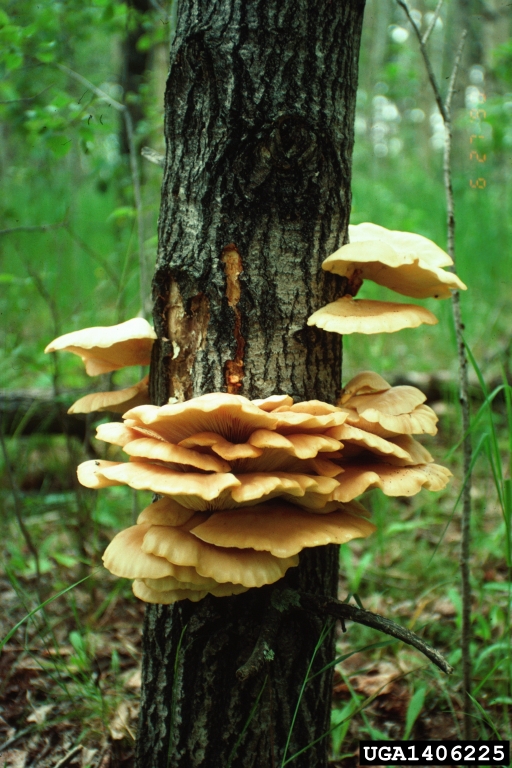 Mushrooms and Fungi - August 31, 2016 Jeff Schalau, Agent, Agriculture & Natural Resources University of Arizona Cooperative Extension, Yavapai County This year, like many others, Yavapai County Cooperative Extension received calls about wild mushrooms growing in response to summer rains. On occasion, we receive calls about whether or not a certain species is poisonous. My answer is always the same: if you are not knowledgeable, consider all wild mushrooms to be poisonous and treat them with caution. The toxins associated with mushrooms/fungi can cause illness and/or death. In some cases, even experts have been fooled and have paid the ultimate price. Rather than dwell on palatability, let’s think about the fungi from a biological and ecological perspective. Fungi are not plants, although it was once thought they were. Today, the fungi are placed in their own separate Kingdom separate from plants, animals, bacteria, and single celled animals. The part of the fungus that we often notice is only the “fruit” or reproductive structure of the organism. The living body of the fungus is a mycelium made out of a web of tiny filaments called hyphae. The mycelium is usually hidden in the soil, in wood, or another food source. A mycelium may fill a single ant, or cover many acres. These webs live largely unseen until they develop mushrooms, puffballs, truffles, or other fruiting bodies. If the mycelium produces microscopic fruiting bodies, people may never be aware of fungus. Most fungi build their cell walls out of chitin. This is the same material as the hard outer shells of insects and other arthropods. Fungi feed by absorbing nutrients from the organic material in which they live. Fungi do not have stomachs. They must digest their food before it can pass through the cell wall into the hyphae. The hyphae secrete acids and enzymes that break the surrounding organic material down into simple compounds they can absorb. Fungi have evolved to use a lot of different items for food. Some are decomposers living on dead organic material like leaves. Some fungi are pathogenic, causing diseases as they use living organisms for food. These fungi infect plants, animals and even other fungi. Athlete’s foot, ringworm, and Valley Fever are fungal diseases in humans. Mycorrhizal fungi live as partners with plant roots providing essential mineral nutrients to the plant in exchange for sugars or other compounds fungi cannot manufacture. You probably use fungal products every day without being aware of it. People eat mushrooms of all shapes, sizes and colors. Yeasts are used in making bread, wine, beer and solvents. Drugs made from fungi cure diseases and stop the rejection of transplanted hearts and other organs. Fungi are also grown in large vats to produce food products, flavorings, vitamins and enzymes for removing stains. Have you ever heard of Vegemite? About 100,000 species of fungi are known, and it is estimated that there may be as many as 1.5 million species of fungi in the world. All fungi are unable to make their own food, and must consume other live or dead organisms in order to survive. Saprophytic fungi get their nutrition from dead organic matter, including fallen wood, dead leaves or dead animal bodies. Saprophytes do not usually hurt living organisms and are beneficial to the environment as recyclers of nutrients. They break down organic matter so that the nitrogen, carbon and minerals it contains can be put back into a form that other living organisms can take up and use. Without saprophytes, the world would be full of dead plant and animal bodies, with no recycling of nutrients to sustain life. We encourage them by providing a moist, aerobic environment when composting. As many gardeners are keenly aware, we have a few plant pathogenic fungi that cause disease, decline, and death of plants in our area. Some of these include powdery mildews, rusts, canker and wilt causing fungi, and the dreaded Texas (cotton) root rot. Just remember that most fungi are beneficial – it is just a few bad actors that can give them a bad name. See links below for additional information. Follow the Backyard Gardener on Twitter – use the link on the BYG website. If you have other gardening questions, call the Master Gardener help line in the Camp Verde office at 928-554-8992 or e-mail us at verdevalleymg@gmail.com and be sure to include your name, address and phone number. Find past Backyard Gardener columns or provide feedback at the Backyard Gardener web site: http://cals.arizona.edu/yavapai/anr/hort/byg/. Additional Resources Mushrooms, Fairy Rings, and Other Nuisance Fungi in the Landscape University of Nebraska, Lincoln Extension extensionpublications.unl.edu/assets/pdf/g1914.pdf Mushrooms, Puffballs, and Fairy Rings Cornell Cooperative Extension www.cceoneida.com/assets/FactsheetPDFs/Mushrooms-Puffballs-and-Fairy-Rings-2013-.pdf Slime Mold Cornell Cooperative Extension www.cceoneida.com/assets/FactsheetPDFs/Slime-Molds-2013.pdf |